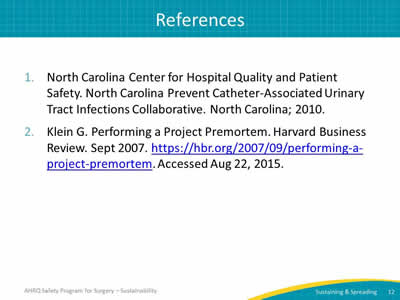Sustaining and Spreading Surgical Safety Improvements: Facilitator Notes
AHRQ Safety Program for Surgery
Slide 1: Sustaining and Spreading Surgical Safety Improvements
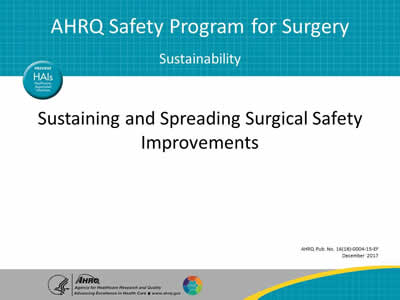
Say:
This module will cover Sustaining and Spreading Surgical Safety Improvements. To preface the sustainability discussions, these modules are designed to develop conversation and reflection on your safety program activities.
Slide 2: Learning Objectives
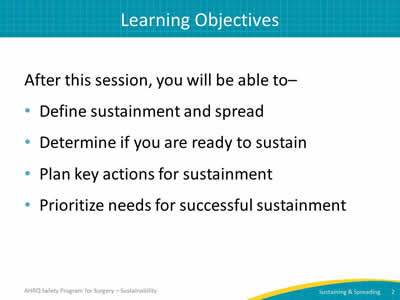
Say:
When a safe surgery project is sustainable, the accomplishments are more likely to persist on the unit.
After this session, you will be able to—
- Define sustainment and spread;
- Determine if you are ready to sustain;
- Plan key actions for sustainment; and,
- Prioritize needs for successful sustainment.
It’s critical to understand what sustainment and spread mean and how they differ. During this module, consider the efforts at your unit or hospital and assess whether they are sustainable. The module provides you with tools to plan for sustainability in your surgical area and prioritize actions for sustainability.
Slide 3: Sustainment Is…
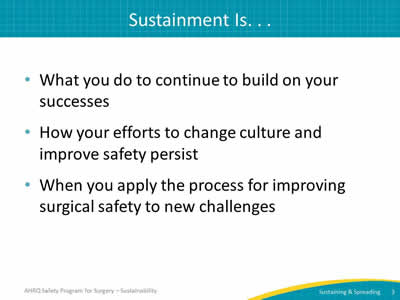
Say:
Sustainability references the continual achievement of quality interventions in the context of culture of safety and quality improvement in your unit or hospital. It also refers to applying the process for improving surgical safety to new challenges.
Slide 4: Adaptive or Technical?
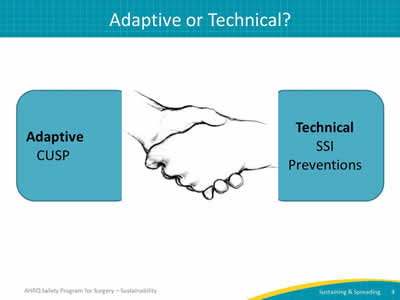
Ask:
Now that sustainability has been defined, what parts of your quality improvement efforts will be tougher for you to sustain?
Say:
Often, teams believe that the tough work will be the technical side, or the surgical site infection (SSI) prevention efforts. For example, teams often think that keeping the safe surgery bundle or processes in place is hard. But technical work is concrete and backed by evidence-based literature.
Rather, it’s the adaptive or cultural components of this work that are not only the toughest to implement, but are also sometimes the tougher parts to entrench in your environment. The adaptive work of CUSP, the Comprehensive Unit-based Safety Program, involves everyone in your unit. Moreover, what works in one environment may not be successful in another area.
Slide 5: Why Worry About Sustainment

Say:
Consider how to sustain your efforts as far in advance as possible. Recidivism, or the return to the previous way of doing things, hurts your sustainment effort. Especially if you have experienced positive momentum around safe surgery activities, any backtracking can stall out that success.
Consider the barriers for sustaining team efforts. Take comfort from knowing that barriers are expected and that sustaining adaptive work is challenging. In fact, sustaining adaptive work has a high failure rate. This is due in part to overlooking cultural considerations. As you develop your sustainability plan, anticipate staff turnover at various levels in the unit or hospital. Also, consider the unit or hospital priorities and how they might compete with the improvement efforts in your clinical setting.
Slide 6: Definition of Spread
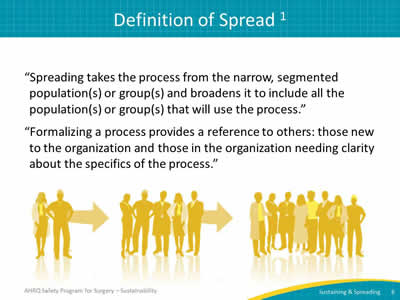
Say:
Due to competing priorities and organizational changes, people often rush into the next project or even spread an achievement into another area of the organization. But first consider what you’ve implemented and how strongly it’s become a part of the new way of doing things. If the process that you want to spread is still taking root, then dissemination may be futile.
Spreading takes the process from a narrowly segmented population and broadens it to include other populations. To do this successfully, formalize the new processes, as it provides a reference for new efforts. When sharing your accomplishments, talk about what you did, how you did it, and how you plan to sustain your efforts.
Slide 7: What Do Effective Teams Look Like?
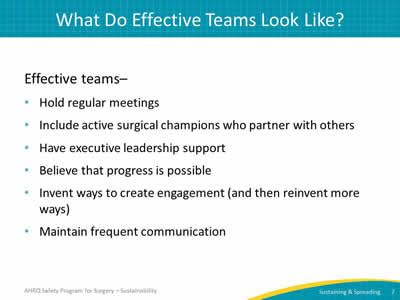
Say:
In order to sustain and spread your initiatives, you need an effective team.
Effective safe surgery teams have active members working for team goals. These teams meet regularly and communicate frequently. Most are honest about performance, including candid discussions about both barriers and successes. They enjoy active surgical champions as well as the participation of an executive leader.
With active executive leadership support, many barriers can be mitigated. Most notably, effective teams believe progress is possible. That is a huge component of whether or not the cultural psyche within the surgical unit will continue to improve.
An effective safe surgery team is diverse, with multiple disciplines represented, such as nurse managers, scrub technicians, anesthesiologists, and surgeons. Include ancillary departments like pharmacy and instrument processing. Diverse teams yield comprehensive solutions that are more likely to sustain safe surgery efforts over time. An effective safe surgery team excites staff members about doing this work.
Slide 8: What Sustainment Strategies Work?
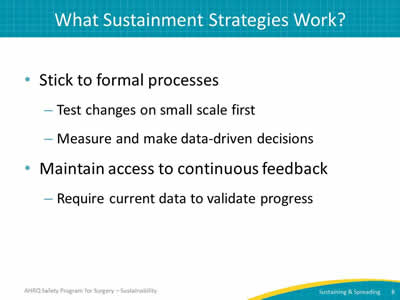
Say:
Let’s turn to strategies that will help with the sustainability effort. The first is to stick to the formal processes. Continue to use the tools currently in place, such as your bundles, processes and structures. For example, the Daily Goals Checklist is a communication tool to share information learned during handoffs and rounding. Consider using this tool as a regular part of operations within other clinical areas. Develop formal processes to sustain efforts, regardless of staff or management turnover. Reinforce these processes.
When proposing a new process, make sure to set up some early wins. Test the changes on a small scale before rolling out a new process. Gather data that verifies your proposed new workflow. For example, test a new tool with one provider on a shift or two. Recognize issues and modify the tool. Share the data with stakeholders that make decisions and use the tool. Require current data to validate progress.
Slide 9: What Sustainment Strategies Work?
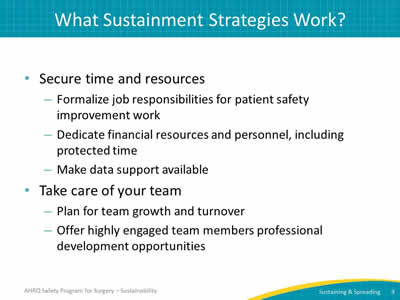
Say:
It is important for people to know who is responsible for what, so formalize the roles and responsibilities on your safe surgery team.
Ask:
Who will continue to schedule the meetings?
Who will share the meeting minutes?
Say:
Ensure all members of your team have a role. If there are resources, identify personnel and a funding source devoted to the safe surgery effort by pitching this need.
Though project implementation may have an end date, that doesn’t mean the work ends. By clarifying what is expected, your diverse team can establish a new mode of operation.
Dedicated financial resources and personnel certainly help with sustainability. To continue to deliver on quality improvement efforts, your senior executive will need to support those efforts with resources and protected time. Data should drive your quality improvement efforts, so make data support available. In other words, identify who will have access to data and who will communicate data.
Make the data available for natural interaction. Ideally, data is available close to the bedside so that providers connect data with their daily actions.
Take care of your team. Listen to the frontline staff members and their suggestions. Be proactive about team turnover. Identify potential team members, including young practitioners, and invite them to join team meetings.
Recommend that highly engaged team members attend professional development opportunities. Many will feel honored and appreciate the chance to bring more skills to their career and the team.
Slide 10: We Are Ready to Sustain: Now What?
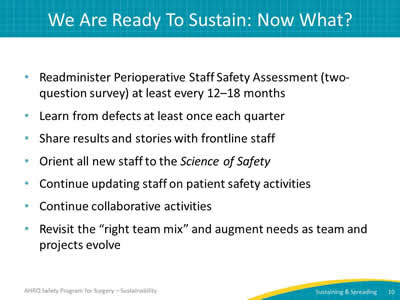
Say:
We have defined sustainability and spread, described effective teams, and discussed applicable strategies. Here is a list of activities to sustain your safe surgery efforts.
Ask:
How will the next patient get a surgical site infection?
What can we do to prevent the next surgical site infection?
Say:
CUSP employs the Staff Safety Assessment, often called the two-question survey. The Safety Program for Surgery has modified the tool for the surgical setting called the Perioperative Staff Safety Assessment (PSSA). Readminister the PSSA at least every 12 to 18 months. Take the opportunity to listen to your front-line staff members and use the responses to prioritize the next activity.
Complete the Learning From Defects tool with your safe surgery team for one defect per quarter. Select a defect, perhaps from your PSSA responses. Walk through the four questions in the Learning From Defects tool:
- What happened?
- Why did it happen?
- How will you reduce the risk of the defect happening again?
- How will you know the risk is reduced?
Share the stories and results with your frontline staff. Even small wins help build momentum. Frontline staff members will feel a sense of accomplishment for their contribution to these exercises.
Ask:
What percentage of your current staff has viewed the Science of Safety video?
Say:
The Science of Safety video provides the basis for understanding the systems. It also highlights the difference between blaming people and recognizing the system factors that enable an error. Develop a plan to include this video in new staff or unit orientations.
Update your staff on safe surgery activities. Plan activities and meetings for the next 12 months. Continue to communicate your team efforts, both the wins (however small) and the challenges. You may receive suggestions for overcoming the challenges.
Continue your collaborative activities and spread your knowledge with other areas. Consider mentoring another department as they begin similar quality work driven by their local frontline staff.
Reflect on your team.
Ask:
What is the right team mix?
Say:
Change members as needed. For example, if your surgeon champion is not involved, or if your executive no longer attends meetings, consider finding a new champion and executive. There may be others who have the time and willingness to sustain the efforts of the safe surgery project.
Recognize that different defects require the participation of new disciplines.
Ask:
Do you have a list of defects that involve an area of the hospital, such as instrument sterilization or the pharmacy?
Say:
It might be time to invite new participants to the team.
Now is an ideal time to evaluate the engagement of team members. When planning to sustain your efforts, consider who is actively participating in team efforts and where efforts have ceased.
Slide 11: Preview of Premortem
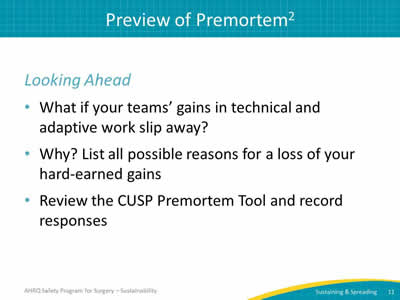
Say:
Anticipate your challenges to sustain your quality improvement work. Strategize ways to overcome these barriers.
In the next module, we will review the premortem exercise. Imagine that your team’s gains in both technical and adaptive work have been unsuccessful.
List all the reasons that your team’s efforts might be lost. Talk to your frontline folks, because many of them can readily identify many reasons. In planning for sustainability, you prepare for the barriers and develop a strategy to overcome them.
Ask:
In preparation for the next module, ask your frontline staff, what will keep your improvement efforts from lasting?
Say:
Frontline staff will already know what will impact your efforts. Share this information with your surgical colleagues and begin the process of eliminating those barriers.
Slide 12: References
